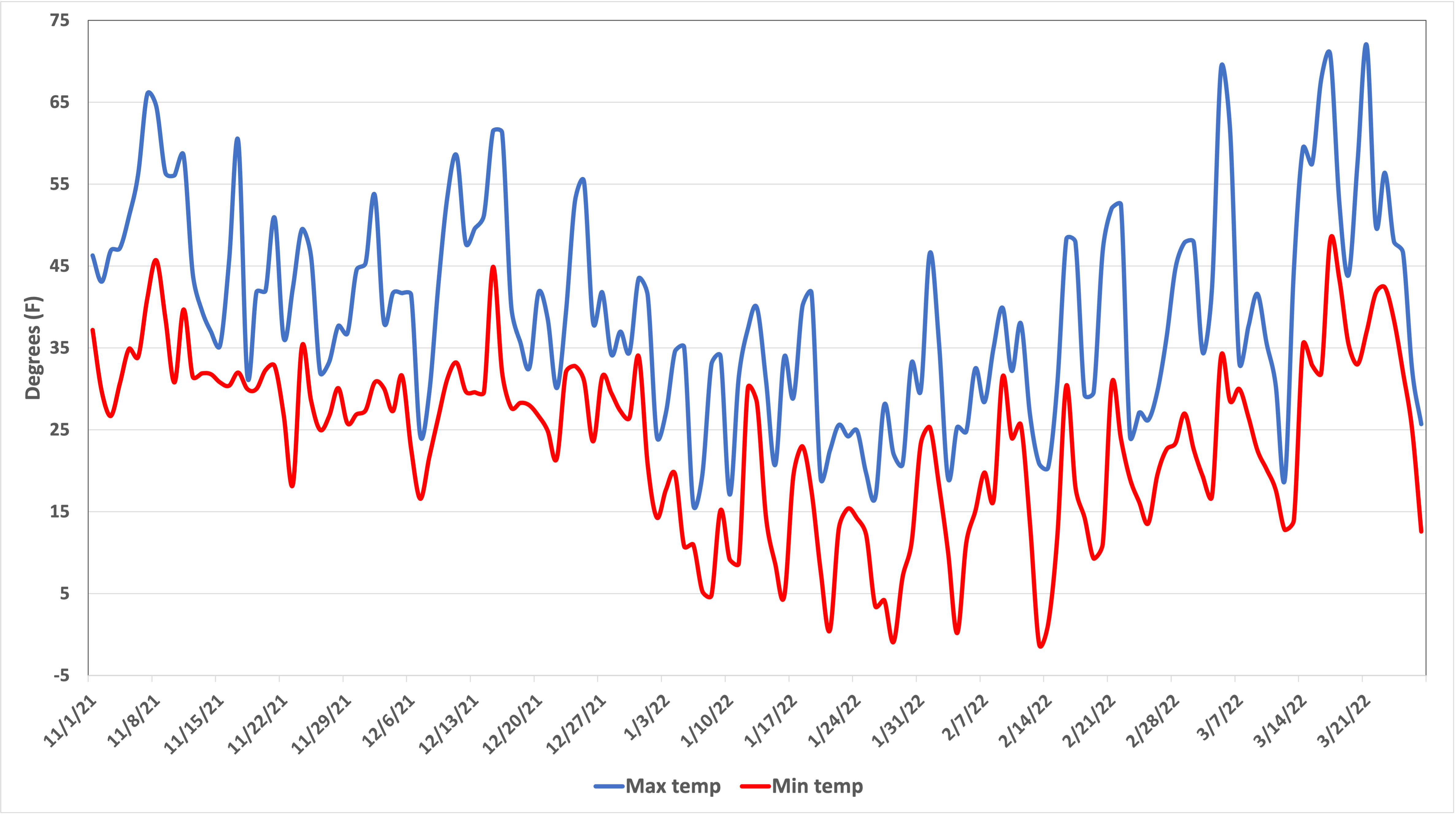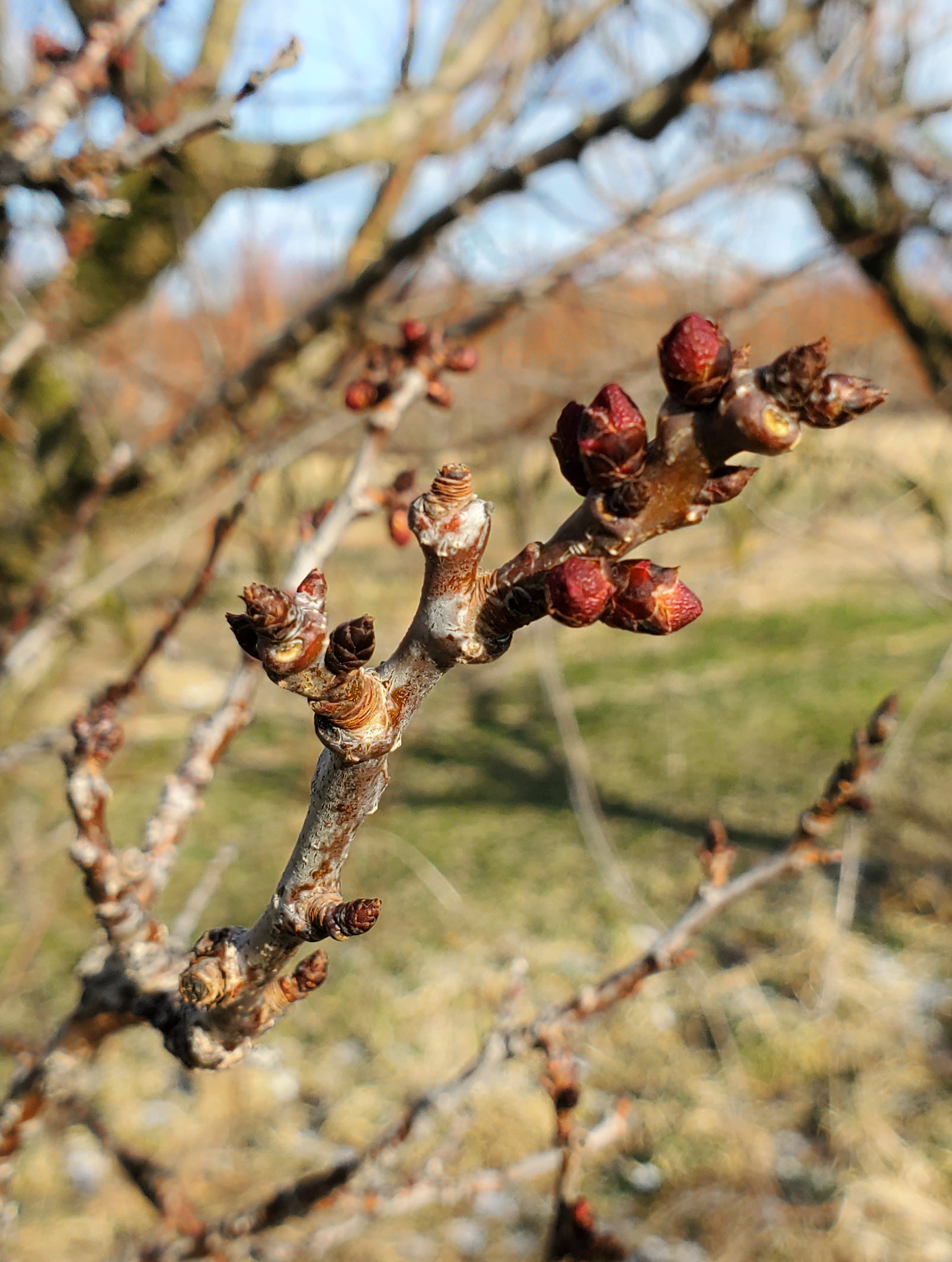Southwest Michigan fruit update – March 29, 2022
This is the first update for the season. All fruit crops made it through the winter in good shape. Buds are swelling on early tree fruit.

Winter
The winter of 2021-2022 was mild. Temperatures seldom dropped below 5 degrees Fahrenheit. Two radiation cold events on Jan. 29 and Feb. 13 resulted in temperatures between 0 and -10 F for much of the region. No significant damage was reported. Winter precipitation was near average. Early ornamental plants started showing signs of movement in mid-March. Some fruit crop buds are just starting to swell now.
Below are the growing degree days (GDD) for the Southwest Michigan Research and Extension Center (SWMREC) near Benton Harbor, Michigan, for the last 15 years. Compare the 2022 numbers to the average for the last 15 years and you can see that we are near average.
|
GDD from Jan. 1 to March 28, 2022, at the SWMREC near Benton Harbor for the last 15 years. | |||
|---|---|---|---|
|
Year |
Base 42 F |
Base 45 F |
Base 50 F |
|
Average |
115 |
82 |
45 |
|
2022 |
109 |
74 |
36 |
|
2021 |
137 |
101 |
57 |
|
2020 |
88 |
55 |
19 |
|
2019 |
49 |
28 |
10 |
|
2018 |
78 |
49 |
18 |
|
2017 |
226 |
161 |
85 |
|
2016 |
163 |
115 |
60 |
|
2015 |
37 |
24 |
12 |
|
2014 |
13 |
5 |
0 |
|
2013 |
41 |
25 |
8 |
|
2012 |
392 |
324 |
228 |
|
2011 |
51 |
31 |
14 |
|
2010 |
88 |
55 |
21 |
|
2009 |
138 |
98 |
48 |
|
2008 |
53 |
35 |
16 |
|
2007 |
170 |
128 |
80 |

March weather
Temperatures have been variable for most of March. Much of the region has already seen a few days with high temperatures near 70 F. Several locations have also reported lows between 10 and 15 F late on March 12 and March 27. At this time, most fruit crops would need to see temperatures near zero for significant damage. The table below shows March was average, overall.
|
Southwest Michigan GDD Summary from March 1 through March 28, 2022 | |||
|---|---|---|---|
|
Station |
GDD 42 F |
GDD 45 F |
GDD 50 F |
|
Benton Harbor (SWMREC) |
92 |
65 |
36 |
|
Lawton (Lawton) |
90 |
66 |
38 |
|
Fennville (TNRC) |
70 |
48 |
25 |
|
Average for the SW region |
86 |
62 |
35 |
The forecast for the upcoming week is for lows near freezing and highs in the 40s. The one exception is Wednesday when a quick moving low-pressure system will bring some warm, wet weather for the day with highs in the 60s and up to an inch of rain. Slight chances of scattered rain/snow mix are forecast for Thursday, March 31, through the weekend.
The medium range forecast for the first half of April is for cooler than average weather and lower than average chances of rain. Longer range forecasts fare for warmer than average temperatures through the rest of spring, and a return to average or above average chances of precipitation.
Tree fruit
The past winter was relatively mild, with the only somewhat significant dips on Jan. 28 and Feb. 13, down to 1 to -7 F. This episode may have affected some peach fruit buds in a few sites. In general, the tree fruit crop prospects are still really good. The sporadic temperatures in March have moved some early crops along, but most have not shown much development yet.
Dry conditions for the last month allowed growers to make good progress pruning. Check blocks for evidence of San Jose scale on branches to determine the need for oil sprays. The fungicide captan is apparently in short supply now. Ziram is fairly similar to captan in the spectrum of diseases controlled but washes off easier.
Apricots buds are slightly swollen.

Peach and nectarine fruit buds are showing signs of swelling. If not already done, peach and nectarine should be protected against peach leaf curl infections. Infections require 10-plus hours of wetting with temperatures in the range of 46 to 55 F. Treatment now can help suppress additional infections when these weather conditions occur even past bud swell. Low levels of copper also suppress bacterial spot populations.
In cherries, no movement has been seen in the cooler areas of this region. Copper sprays can be safely applied to cherries. Copper applications may reduce bacterial canker in cherries.
In plums, Japanese plum fruit buds are visibly swollen, with European plum lagging behind. Prune out black knot and dispose of the knots by burning or removing from the orchard. Sanitation is an important step in managing this disease.
Apple early varieties Zestar, Macintosh and Jonathan are at silver tip in Berrien County, and likely are showing first green in warmer, southern sites away from Lake Michigan. Scab sprays will be needed to protect against future rains as green tissue emerges. Copper sprays can provide early scab control and fire blight suppression. Protectants are preferred over systemic fungicides at this time of year for scab control.
Pear buds are slightly swollen. Bud scales are starting to separate.
Small fruit
Grapes show no movement.
Blueberry flower buds appear swollen, leaf buds do not show growth yet. Growers still have time to apply copper, Sulforix or lime sulfur products to suppress early season diseases.
Strawberries have greened up and new leaves are starting to emerge from the crown. Overwintering mulches should be removed and raked between the rows. Some growers are putting out floating row covers. Growers are looking at early season herbicides to control overwintering weeds. When selecting an herbicide, make sure and check the pre-harvest interval (PHI). We are getting to the part of spring where some herbicide PHIs are cutting it close to predicted harvest dates.
Brambles show some movement with swollen buds. Dormant pruning should be completed soon. In summer bearing raspberries, last year’s primocanes should be headed (cut back) to the desired height and any remaining floricanes from last year should be removed. Fall bearing raspberries should be cut or mowed to the ground. Lime sulfur treatments for anthracnose can still be applied.
Upcoming meetings
Our regular southwest Monday fruit IPM updates will be moving to a hybrid format. The meetings will be held in-person with virtual attending also available online. Our first meeting is Monday, April 11, at 5:30 p.m. You need to register to receive the Zoom link and password for these meetings. The webinars are free and two pesticide applicator credits are available for each meeting. The same Zoom link will be used with all the Monday meetings—you only need to register once.
Related articles
- Welcome Cheyenne Sloan, new blueberry and small fruit educator
- Southwest Michigan fruit update – 2021 review
- Freeze damage depends on tree fruit stage of development
- 2013 bloom dates for southwest Michigan tree fruit crops
- Using Enviro-weather’s regional overnight temperature report during cold events
- Treat peach leaf curl now
- Managing bacterial canker in sweet cherries: What are the options?
- Early insect control with horticultural oils
- Dormant oil for tree fruit pest management in 2015
- Scouting and management of mummy berry in blueberries
This work is supported by the Crop Protection and Pest Management Program [grant no 2021-70006-35450] from the USDA National Institute of Food and Agriculture.



 Print
Print Email
Email
